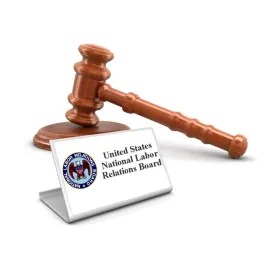-
Democrats now hold a majority of seats on the National Labor Relations Board (NLRB). The new Democratic majority on the NLRB became official on Saturday, August 28, when President Joe Biden’s nominee David Prouty was sworn in as the fifth and final member, replacing management-side attorney and Republican appointee William Emanuel, whose term ended the day before. Democrats now control three of the NLRB’s five seats and are expected to issue decisions that will help unions win elections, loosen restrictions on expressing support for labor in the workplace, and tighten joint employment standards, among a host of other potential changes.
-
The NLRB’s General Counsel issued a memorandum describing an ambitious set of policy goals. On August 12, the new NLRB General Counsel (GC) Jennifer Abruzzo issued Memorandum 21-04, previewing the many policy goals she intends to pursue. The memo sets an aggressive agenda that would revisit many Trump-era NLRB decisions and other NLRB rules and cases, including the test for determining employee status, the boundaries of protected worker activity, and the extent of employers’ duty to bargain with unions. The memo requires all NLRB regions to submit cases involving the enumerated subjects to the Division of Advice. The previous GC, Peter Robb, issued a similar memorandum (GC Memo 18-02) at the beginning of his term, which resulted in numerous changes in case law by the Trump NLRB. It is expected Abruzzo’s tenure will be similarly impactful, given the Democratic majority now in control of the NLRB is likely to be receptive to Abruzzo’s policy goals. The memo seeks to achieve some of the objectives included in the Protecting the Right to Organize (PRO) Act (which, at this time, appears unlikely to pass the Senate) and many others. Demonstrating that some policy changes are already underway, the GC’s office released a memo (Memorandum 21-06) directing NLRB Regions to revisit how they pursue remedies in unfair labor practices cases.
-
The NLRB stated a willingness to explore a new make-whole remedy, and a new NLRB GC memo echoes that message. In The Voorhees Care and Rehabilitation Center, 371 NLRB No. 22 (Aug. 25, 2021), the NLRB telegraphed its intent, in a future case, to consider expanding its remedies from backpay and reinstatement to include all forms of compensatory damages. In GC Memorandum 21-06, issued on September 8, Abruzzo stated, “Like the Board, I, too, welcome the opportunity to revisit remedies, and during my tenure as General Counsel, I expect to periodically issue remedy updates.” Abruzzo directed NLRB Regions, in cases involving unlawful firings, to seek compensation for consequential damages, front pay, and liquidated backpay in a combined complaint and compliance specification where appropriate. The GC went on to say she would issue “another memorandum shortly that sets forth the types of remedies that Regions should incorporate in settlement agreements.” It is an open question whether the NLRB has the authority under the National Labor Relations Act (NLRA) to expand remedies by case decision, or even by rulemaking. The NLRA itself speaks only to “backpay” and reinstatement.
-
Efforts are underway by Congressional Democrats to attempt to pass key components of the PRO Act through budget measures. Some legislators appear to be using the congressional “budget reconciliation” process to pursue PRO Act goals after the measure failed to independently advance through Congress. Once the U.S. Senate passed a $1 trillion infrastructure bill in August, efforts began in the House of Representatives to adapt the Senate bill for House consideration. That process, referred to as budget reconciliation, culminates in votes by both chambers on the “reconciled” budget measures. Significantly, the budget reconciliation process allows passage of budget measures by a simple majority in the Senate and House, as opposed to other legislative measures (which require a supermajority for advancing to a final vote). The reconciliation process is still underway. Recent versions of measures being adapted by the House Committee on Education and Labor appear to include key components of the PRO Act, including new civil penalties for employers found to violate the NLRA and personal liability for directors and officers. The provisions also would make it an unfair labor practice for employers to pursue certain common measures, like permanently replacing strikers, locking out employees, and requiring attendance at “captive audience” speeches. It is ultimately up to the Senate parliamentarian to decide whether measures attached to a budget bill are sufficiently budget-related to merit inclusion in a reconciliation bill. It remains to be seen how the parliamentarian will view the inclusion of PRO Act provisions in the budget reconciliation measures.
-
General Counsel Abruzzo’s Memorandum 21-05, “Utilization of Section 10(j) Proceedings,” reaffirms the NLRB’s emphasis on seeking injunctive relief in federal court. The memorandum, released on August 19, makes clear the GC “intend[s] to aggressively seek Section 10(j) relief where necessary to preserve the status quo and the efficacy of final Board orders.” The GC outlined the typical cases that may be suitable for injunctive relief:
-
Discharges that occur during an organizing campaign;
-
Violations during organizing campaigns in which a Gissel bargaining order is appropriate;
-
Violations post-certification, when parties should be attempting to negotiate their first collective bargaining agreement;
-
Unlawful withdrawals of recognition from incumbent unions; and
-
Successors’ refusal to bargain or refusal to hire.
The memo urges NLRB Regions to continue to assess incoming cases to determine if there is a need for injunctive relief, particularly “where the unfair labor practices are having an impact on employees’ Section 7 rights or the bargaining process such that a final Board order will come too late to effectively restore the lawful status quo.” Such cases are submitted to the Injunction Litigation Branch, which decides whether to pursue injunctive relief. In the past, the NLRB has sought 10(j) relief in only a very small percentage of cases. For example, in 2012, the Board sought only 58 authorizations for 10(j) relief, representing only 0.003 percent of all charges filed. It appears likely that GC Abruzzo will aggressively pursue 10(j) relief, or the threat of potential 10(j) proceedings, as leverage in pursuit of settlement.
Co-author Christopher M. Repole









 />i
/>i
